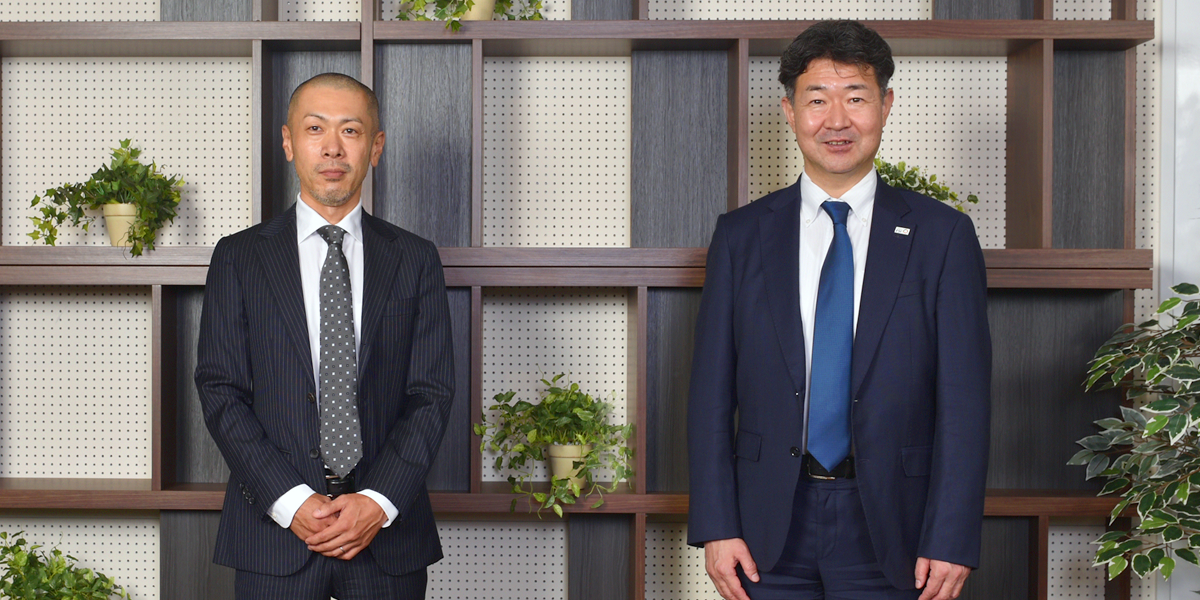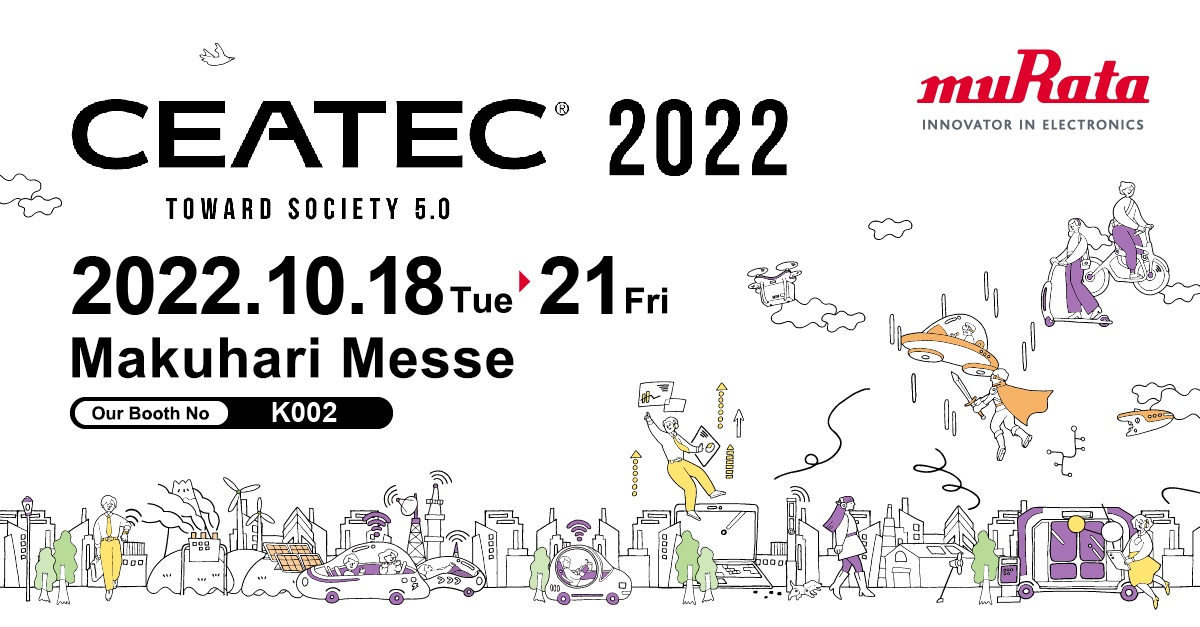Building IIoT Systems to Serve as the Foundations of DX and GX with Beyond 5G/6G and More Advanced IoT Devices (Part 2)
Social systems and business are undergoing reforms through digital transformation (DX) and green transformation (GX) aiming to realize a sustainable and prosperous society. It is essential to utilize industrial IoT (IIoT) systems, which serve as the foundations to utilize digital information to implement DX and GX. Professor Nakao of the University of Tokyo is researching a wide range of technologies with an overview of entire IIoT systems, from underlying technologies to applications. Tomokazu Shimomae of Murata Manufacturing is in charge of planning next-generation information and communications-related business. The two of them discussed the state of IIoT systems to meet the demands of the times. They also talked about the present and future of the technologies sought for that. In Part 2, we introduce what they discussed from their respective perspectives as a researcher and a business operator about the technologies sought on the edge side in IIoT systems and the direction of the evolution of that.
In Part 1, we introduced the state of the development of the communications infrastructure essential to building the industrial IoT (IIoT) systems, which will serve as the information foundations to implement digital transformation (DX) and green transformation (GX). We also looked at the outlook for the development of those next-generation technologies. However, there is also a need for further evolution of technical elements other than the communications infrastructure to more effectively and efficiently resolve social issues and create business value.
In Part 2, Professor Nakao of the Department of Systems Innovation, School of Engineering, University of Tokyo, explains the architecture of IIoT systems and the technical requirements sought in devices placed on the edge side. Tomokazu Shimomae, Manager of the Technological Development Department in Murata Manufacturing, introduces Murata's initiatives to achieve that.
Realizing Real-time Performance and Reliability with Edge Computing
There has been an increase in the number of opportunities to hear the term "edge computing" among the trends in information processing systems.
In general, IoT devices equipped with sensors placed on-site (the edge) collect data and then transfer it to a cloud such as a data center via a network in IIoT systems. Valuable information is then extracted by applying analytical processing to the big data stored there. Performing most information processing in the cloud enables even more advanced analysis and optimization while efficiently utilizing a wealth of computing resources.
In contrast to this, edge computing has system architecture in which some of the information processing is actually performed on the edge. Information processing is optimally shared between the edge and cloud respectively based on some kind of rationality.
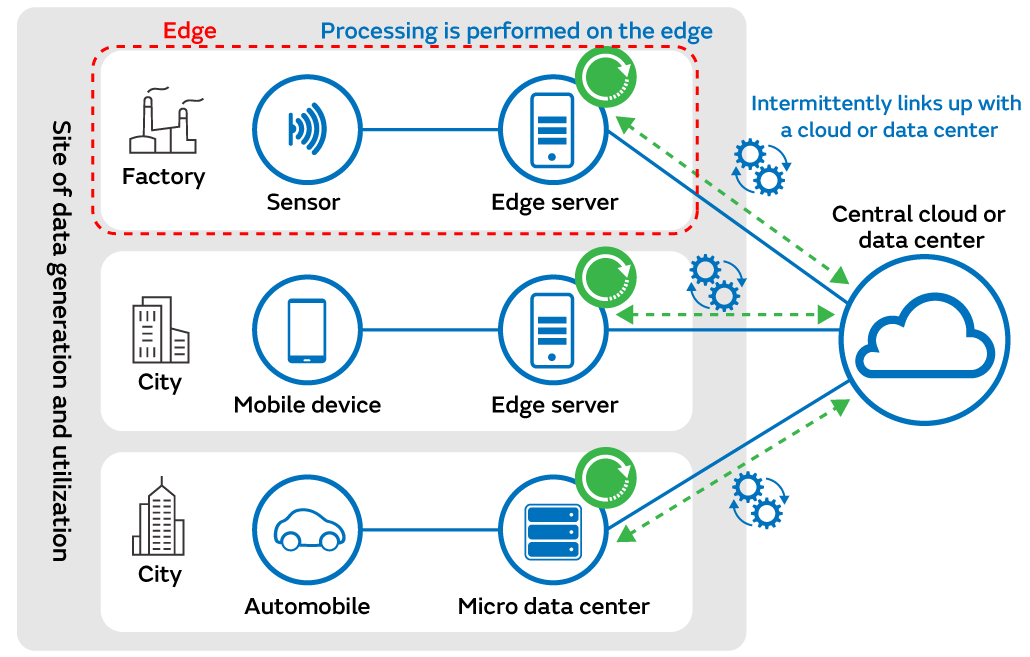
Professor Nakao explains the benefits of introducing edge computing into IIoT systems: "Feedback at low latency becomes possible and decentralization of computing resources is realized. In terms of low latency, it becomes possible to realize factories, industrial plants, social infrastructure, and other facilities that can autonomously adjust operating conditions to promptly respond to changes in the situation by placing your own computational resources near the base station in an IIoT system based on local 5G in particular. Moreover, when computing resources are concentrated in a cloud or other location, we are more likely to see the entire system go down due to a single failure called a single point of failure (SPOF) or a failure caused by congestion (congestion: when data becomes concentrated and built up in one place). It is possible to realize a highly reliable system by decentralizing computational resources utilizing edge computing. Furthermore, limiting data transfer to public clouds outside the company also produces the benefit that it is possible to protect privacy and confidential information." These benefits make edge computing an important solution in the realization of applications seeking real-time performance and reliability of processing such as with smart cities, smart factories, unmanned stores, and self-driving cars.

Professor Akihiro Nakao
Professor in the Department of Systems Innovation, Graduate School of Engineering, University of Tokyo
Specially Appointed Advisor to the President of the University of Tokyo
Completed a master's course in the Department of Information Engineering, Graduate School of Engineering, University of Tokyo, in 1993. After working at the IBM Austin Research Laboratory in Texas, U.S., and the IBM Research – Tokyo, acquired a master's degree and Ph.D. in Information Studies from Princeton Graduate School in the U.S. Has been teaching at the University of Tokyo since 2005 and has held his current posts since April 2021.
Insight into Optimal IIoT Systems from the Perspective of Social Rationality in Addition to Technical Rationality
Actual data transfer speeds vary greatly in IIoT systems depending on the speed and latency time of the network that connects edge devices, access points, servers, and other devices, and the number of devices that can be connected simultaneously. These will all improve as the mobile phone infrastructure connecting edge devices evolves to 4G, 5G, and then 6G. Therefore, there may be people who think that it will be possible to gather all information processing in the cloud without going to the effort of using edge computing if the communication infrastructure evolves.
However, in practice, there is a limit to how far the latency time can be shortened. Furthermore, looking at this from security, privacy, and similar viewpoints, even if we could concentrate all information processing in the cloud in technical terms, there is likely to be a desire to avoid placing data in overseas data centers from the perspective of data governance. There are also cases for which there is a desire to place data in both the cloud and on premises from the perspective of business continuity planning (BCP).
"It is necessary to select the optimal architecture from the perspective of social rationality in addition to the perspective of technical rationality, as IIoT systems are a part of the foundations of society. Accordingly, edge computing is essential to satisfy the multifaceted requirements sought in IIoT systems" (Professor Nakao). Technical selection from such a multifaceted perspective is also now sought in manufacturers that develop the technical elements that constitute IIoT systems and provide the components and technologies essential to building those systems. Shimomae says the following: "Murata can foresee future technologies in line with technical rationality based on the accumulation of experience and technology from long-term relationships with our customers in the telecommunications industry. However, it is not easy to ascertain the situation with social rationality kept in mind. We believe that linking up with universities, other companies, research institutes, and other organizations with a wide range of knowledge will become important."
Professor Nakao also tells us the following: "It will become possible to collect and transmit vast quantities of data in an instant with Beyond 5G. Therefore, there is the possibility of inadvertently infringing on privacy. There is a need for a structure in which we can examine the appropriateness of the technologies to be implemented in society from a wide range of perspectives such as ethics, legal systems, and public policies in addition to that of engineering researchers in universities." Professor Nakao's laboratory has already installed a local 5G base station on a mountain trail of Mt. Fuji to conduct demonstration experiments on technologies that can ascertain the number of people coming and going on the trail without identifying personal data through anonymous sensors.

Collecting Information with Greater Added Value by Downsizing and Reducing the Power Consumption of IoT Devices
There is one more important issue in the development of technologies for the utilization of IIoT systems and their evolution: the downsizing and reduction in power consumption of IoT devices. The key to evolving IIoT systems is that it is essential to make it possible to install many more IoT devices in the locations where we want to collect data.
It is important to reliably install and operate the necessary number of IoT devices in any location to collect valuable information. Nevertheless, restrictions apply to installation if IoT devices have a shape that is too large of if they consume too much power.
For example, let's consider an IoT device that detects vibrations, temperature, and other information of a robot hand attached to the end of the moving arm of an industrial robot. Mounting a large IoT device may interfere with the movement of the robot itself. Therefore, downsizing is essential. Moreover, if we promote the downsizing of IoT devices, people will become able to live their lives with them on their person without discomfort. It will also become possible to install them in all places such as automobiles and other forms of mobility, home appliances, and building and office equipment without feeling that they are out of place and without being sensed as a foreign object. The utility value of IoT devices has been increasing by downsizing them to the point where their existence is not felt.
It is essential to downsize the components mounted to IoT devices to downsize them. Shimomae tells us the following: "In addition to diverse components mounted to IoT devices such as capacitors, inductors, filters, power amplifiers, and sensors, Murata has accumulated diverse technologies relating to the development and manufacturing of modules that combine those components. We are aiming to further downsize and improve the performance of the components indispensable to the configuration of IoT devices by further developing the design and manufacturing technologies we have cultivated so far."
Lowering the Power Consumption of 50 Billion IoT Devices
It will also be necessary to reduce power consumption to install a vast number of IoT devices in various locations around the world.
It is possible that as many as 50 billion IoT devices will be installed and utilized by 2030. That will be a number several orders of magnitude larger than the number of smartphones that have spread in society and are a leading example of electronic devices widely used at the present time. The operation of so many electronic devices at the same time will consume a vast amount of power. Professor Nakao identifies the importance of reducing power consumption: "Achieving carbon neutrality has become an issue that the whole world must work on together. If the IoT devices utilized in implementing GX themselves consume a lot of power and become a factor in increasing CO₂ emissions, it will be a case of putting the cart before the horse. In addition to reducing the power consumption of hardware itself such as sensors and microcomputers, we need to take measures from a diverse range of approaches. For instance, we could decrease wasteful communications by devising communications protocols and introduce advanced power supply management through intelligent adaptive control."
It is also essential to take measures at the component level to promote the lower power consumption of IoT devices. "Murata is searching for technologies that can collect data efficiently while minimizing the power consumption of each unit. For example, to reduce the loss in the power amplifier, which consumes a lot of power in the RF circuit indispensable for wireless functions, we are considering the optimal process and design methods. At the same time, we have been promoting multifaceted improvements by acquiring ETA Wireless through an M&A. That is a company in the U.S. with digital envelope tracking technologies, which is one of the methods of improving efficiency" (Shimomae).
Aiming for Ideal Maintenance-free IoT Devices
Ideally, small and maintenance-free IoT devices are needed to build an IIoT system that can collect and utilize information with value. Often, there is a trend for added value to be higher with data collected in locations and at times when access by humans is difficult. That is because unknown data could not be collected manually until now. It will become possible to collect real-time data on a regular basis from all locations such as harsh environments that cannot be accessed by people, inside machines, and even in the sea or air with small and maintenance-free IoT devices.
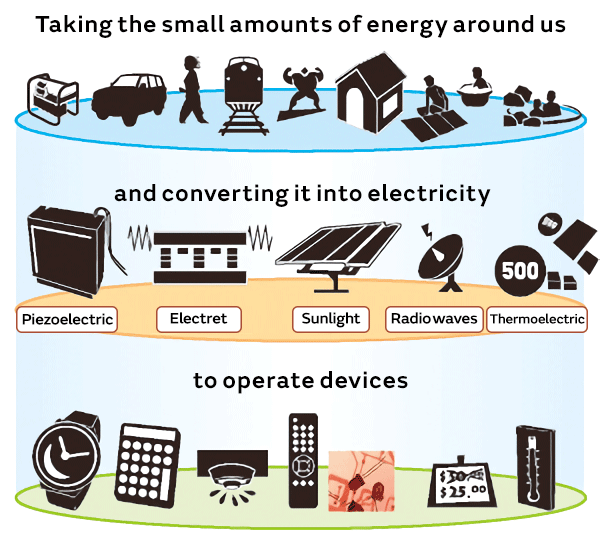
Aiming to realize such an ideal, attention is now focusing on the utilization of energy harvesting (power generation from the environment) using the energy inherent in the surrounding environment such as with light, vibrations, and temperature differences by turning it into power. Shimomae hints at the size of the market value of this technology: "Energy harvesting technology is still in the development stage. The market is also still in its infancy. However, if we can utilize it, we may be able to create services with new hidden value in various fields such as smart houses, smart grids, smart communities, smart factories, and smart health care. That is in addition to creating devices that can operate continuously over a long period of time. The potential market is extremely large."
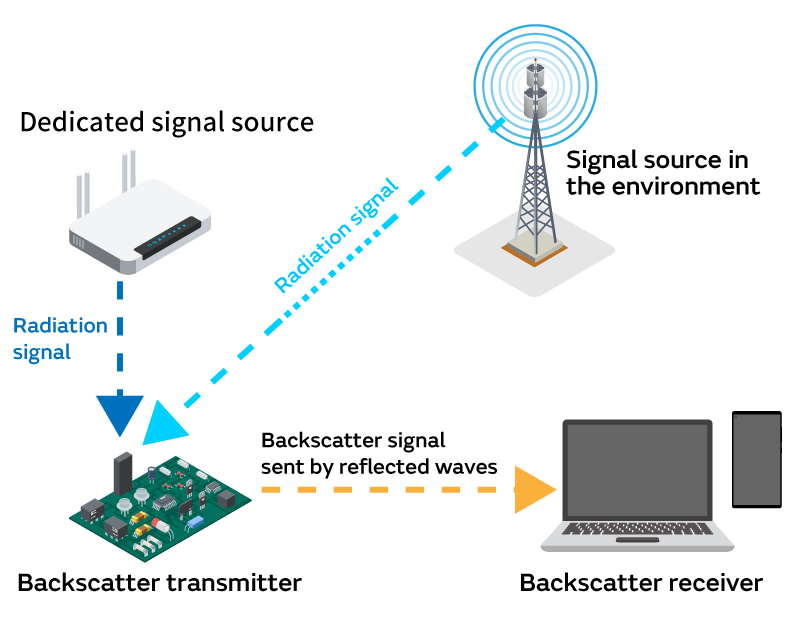
People are also becoming interested in a technology called backscatter communication as a technology that realizes IoT devices that can be used with zero energy. Backscatter communication is a technology that transmits data just by switching the impedance of an antenna at high speed with a switch without producing carrier waves on the side that is transmitting data. This technology transmits data by modulating radio waves to turn them on and off with an antenna reflecting and absorbing the radio waves in the environment such as for televisions and Wi-Fi instead of emitting radio waves by itself. There is no need for an amplifier in the device on the transmitting side. Therefore, it is possible to transmit data with extremely low power. However, this is a future technology that has not yet been put to practical use. Professor Nakao has the following to say about this technology: "Advanced wireless technology is essential to realize backscatter communication. I have hopes for this in Murata Manufacturing with your wealth of achievements in this field."
Communications infrastructure (5G and Beyond 5G/6G etc.), IoT devices used on the edge side, and other technological elements of the IIoT systems essential to implementing DX and GX are steadily being realized and are continuously evolving. The realization of a sustainable and prosperous society through the progress of DX and GX will be supported by the further evolution and social implementation of these technological elements.

